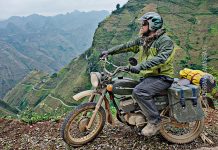
The wild nature of Eastern Finland is at its best during bright summer nights. The remote Kuhmo area, near Russian border, boasts with world-class outdoor adventures: bear watching in Finland, trout fishing and canoe trips to uninhabited islands.
Text and photos by Ville Palonen
Movement on the opposite shore of a small lake catches my eye. Even before raising my binoculars I know what the dark shape is: a full-grown brown bear. He’s heading directly towards me.
As the bear sways closer I watch him through my camera, heart racing.
The beast is massive. It’s easy to understand why brown bear is dubbed as ”the king of the forest”. It’s the national animal of Finland, a mythical creature that has always been feared and respected. Bear has dozens of nicknames in Finnish language, and countless places are named after the majestic beast.
It’s easy to understand why brown bear is dubbed as ”the king of the forest”.
There are roughly 1500 bears in Finland, but wild encounters with them are very rare. Kuhmo is the best bet for bear spotting. This eastern region has one of the highest large predator densities in the country.

Brown bear (Ursus arctos) is not aggressive towards people like its North American subspecies, grizzly bear (Ursus arctos horribilis). Nevertheless, my hands tremble when I take the first pictures. Fortunately, I’m safely inside a hide – a tiny shed built for wildlife watching – with my host, 36 years old Sami Rautiainen. He runs bear watching safaris with his father, wildlife photographer Lassi Rautiainen. Wildlife Safaris Finland, Finland’s first commercial predator watching business, was started in 1988 (by the name of Articmedia). Now it has 14 hides in 4 locations just a stone’s throw from Russian border.
Guests must stay quietly inside the hide around the clock.
The 6-square-meter hide has no frills: narrow windows, a dozen shooting holes for cameras, camping mattresses on the floor for sleeping and a couple of empty water canisters behind the door for peeing. There’s no mosquitoes – a little surprising for a Finnish summer evening – but the inside temperature resembles a poorly heated sauna. The stakeout can be quite an exhausting experience. Guests must stay quietly inside the hide around the clock, typically from 6pm until 7am.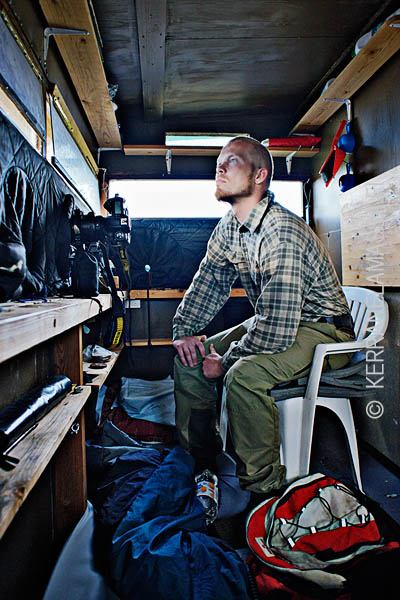
We’re sitting on plastic garden chairs and watch the bear. He stands at the swamp less than 50 meters from us, tearing apart a pig carcass. Every now and then he glances directly into my camera. He knows that he’s being watched.
”A pig carcass is tied down by a rope, so the bears wouldn’t carry it away”, Rautiainen whispers. ”A full-grown bear can eat 10 kilos at a time, and he digests the meal for a couple of days.”
Eye to eye with a beast
Not all the local residents are happy about feeding large predators almost in their backyard. Critics argue that bear and wolf watching tourism makes these naturally shy animals too accustomed to humans.
On the way to the bear watching camp I dropped by a local sheep farm. Over a cup of coffee the owner recalled his troubles with predators – in 2011 a lone wolf slaughtered 14 sheep – and criticized the practice of feeding meat to bears in summer time.
Brown bears are omnivorous – their diet consists of meat, berries, plants, ants and honey – but usually they kill moose or deer only in autumn before hibernation or in spring right after getting up from their winter nest. Rautiainen assures that bears who visit pig carcasses eat also natural food like berries.
A few years ago bear population in Kuhmo had increased so much that officials granted exceptionally large numbers of hunting permits.
A few years ago bear population in Kuhmo had increased so much that officials granted exceptionally large numbers of hunting permits. Between 2010-2012 more than 50 bears were shot, 25 in one year alone. The population decreased as intended, so in 2013 and 2015 no more than 5 bear permits per year were granted.
Even though bear hunting is prohibited in the 10-square-kilometer area around the hides, it has had an effect on predator watching business. Few years ago up to a dozen bears could visit a carcass during one night. Sightings have dropped, but it’s still probable to spot bears, wolves and wolverines in most summer nights.
After half an hour of gluttony the bear gets up slowly and begins slouching across the swamp. ”He’s heading to the next hide a kilometer away”, says Rautiainen. ”There’s a Norwegian group, I’ll text them to be ready.”

After we’ve celebrated our bear sighting with a small cup of warm beer Rautiainen describes the most amazing thing he’s seen from a hide. ”Some years ago I watched with my wife how a wolf stalked a young bear. He ambushed and chased the surprised bear up to a tree. It might have been nothing but a game for the wolf, but often they rob meat from bears, too.”
When a carcass is close to a hide, timid wolves tend to keep their distance.
When a carcass is close to a hide, timid wolves tend to keep their distance. They wait patiently until a lone bear rips off a piece of meat, and work as a team to steal it from him when he strays further.
The sun has set, but a clear sky makes the night bright. A pack of wolves howl about a kilometer away. Surprisingly, the sound isn’t spine-chilling at all. It’s sad and woeful.
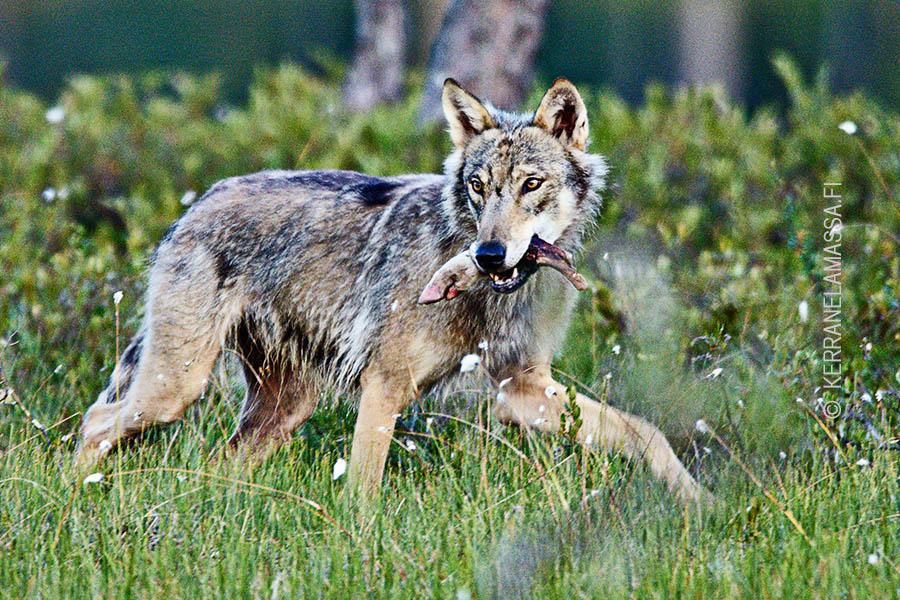
Suddenly Rautiainen whispers very quietly. A lone wolf is approaching across the swamp behind us. I hold my breath and wait until the grey beast has jogged into my massive telephoto lens’ sector, and then I press the shutter. The wolf stops and stares into my eyes for a second. Then he trots into the forest patch behind the carcass, and returns almost immediately with a pig hoof in his mouth.
Then the wolf disappears to the swamp silently like a ghost.
Read more: Bear Watching in Finland
Miniature Alaska
A couple of days after encountering the king of the forest I’m sweating in the middle of Kuhmo’s second largest lake, Lentua. Paddling a 2-seater canoe alone is hard work. The canoe is steady enough, but it’s difficult to keep the course in headwind. I zigzag along like a drunken eel.
There’s an excuse for my ungraceful paddling style. I’m a complete novice, and got only a 10-minute crash course at my canoe trip’s starting point. 3 days of solo paddling should teach me a lesson or two more.
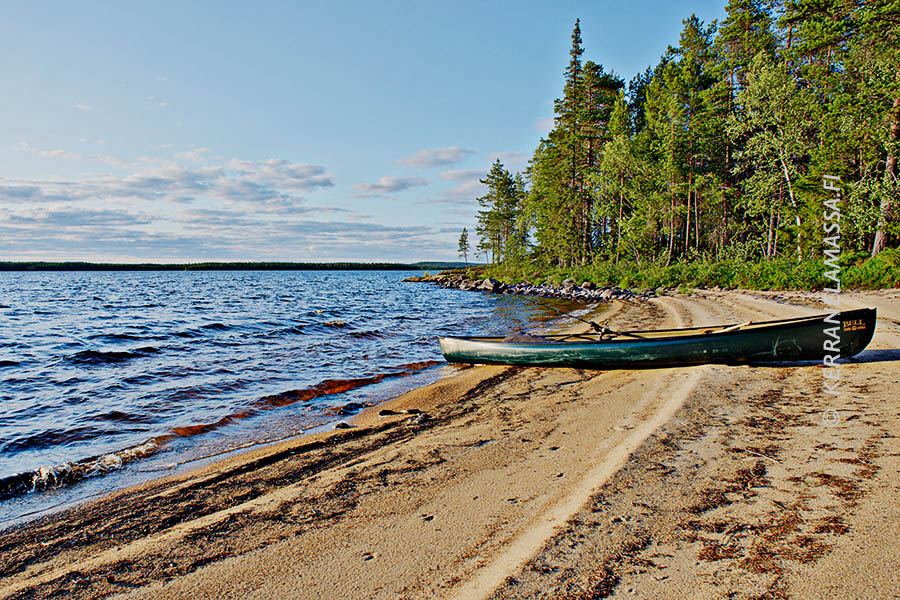
Renting a canoe or a kayak is a perfect way to take new perspective into Kuhmo’s great outdoors. With its wildlife and rugged landscapes, the region resembles of a miniature Alaska. 80% of the land is covered by forest, and the map is dotted with hundreds of smaller and a dozen larger lakes. The most famous of them is Lentua, familiar from Finnish painter Akseli Gallen-Kallela’s illustrations based on the national epic, Kalevala.
There are no summer cottages on sight, only green pine forests lined with golden sand beaches.
Lentua is a great destination for a few days of paddling. Most of the lake is nature reserve, so islands are uninhabited. There are no summer cottages on sight, only green pine forests lined with golden sand beaches. The only thing that reminds of civilization is a network of fireplaces and lean-to shelters. They’re managed by Finnish forest service, Metsähallitus, and anybody can use them free of charge.
The crown jewel of Lentua’s refuges is a wilderness hut in Lehtosaari island. It’s located in an intersection of popular canoeing routes that follow historical tar transporting routes.
I arrive in Lehtosaari in late afternoon. Exhausted and an aching blister in my palm, I’m rewarded with a surprise. The island is deserted. I double check with binoculars: there’s not another human being in sight.
Everybody’s smoked
An uninhabited island brings out my hunter-gatherer personality. I pick blueberries in the pine forest for half an hour, and then I head for catching a dinner.
Pike, the most voracious predator fish in Finland, is often underrated and sometimes hated for eating valued species like brown trout and freshwater whitefish. Some inconsiderate anglers along trout fishing rapids even kill pikes just for the sake of it. This absurd hate is related to some hunters’ attitude towards wolves: those bloodthirsty beasts eat the prey that belongs to me!
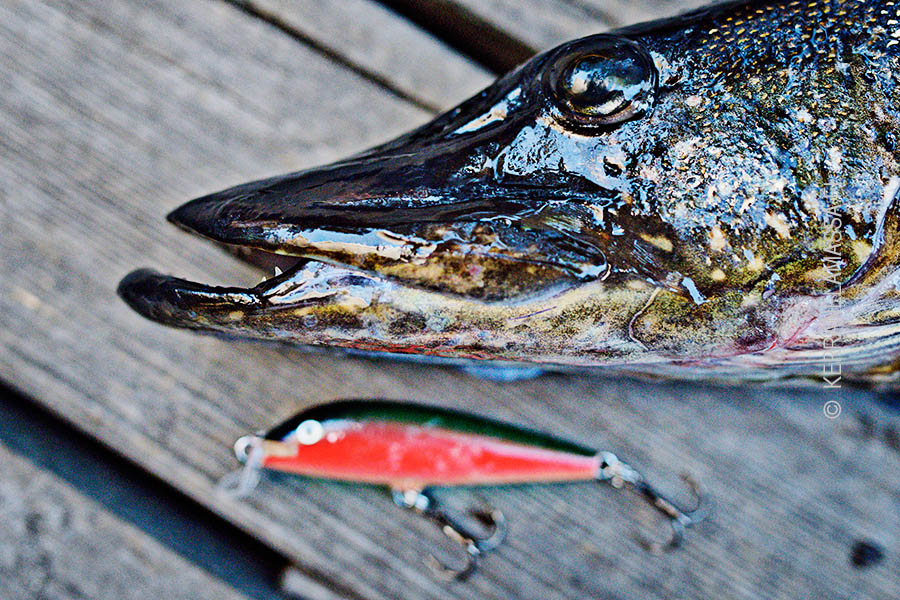
Nevertheless, a properly prepared pike makes a superb meal and fortunately for me they’re relatively easy fish to catch. After an hour of casting I return to the wilderness hut with a decent-sized pike. I gut and cut the fish and place the fillets above a fire. The dinner menu is mashed potatoes, smoked pike, and blueberries for a dessert.
Next day I smoke myself.
A genuine smoke sauna is an unforgettable experience by any standards.
Lehtosaari cabin is a great refuge for fishermen, paddlers and skiers. It has two rooms equipped with wood stoves and bunk beds, outhouse and firewood shed. But the truly amazing detail is the sauna. The tiny hut on the lakeshore is not an ordinary steam room. It’s a genuine smoke sauna, an unforgettable experience by any Finnish or foreign standards.

The sauna has no chimney, so smoke fills the room when I light a fire under the stove. I feed it with logs for almost 4 hours. Finally the unusually large stove – about half a cubic meter of rocks – is properly heated. I undress and close the door behind me.
The walls are black with a thick layer of soot, and when I throw water on stones a cloud of white ash rises into air. I bathe for two hours, jumping to the lake every now and then.
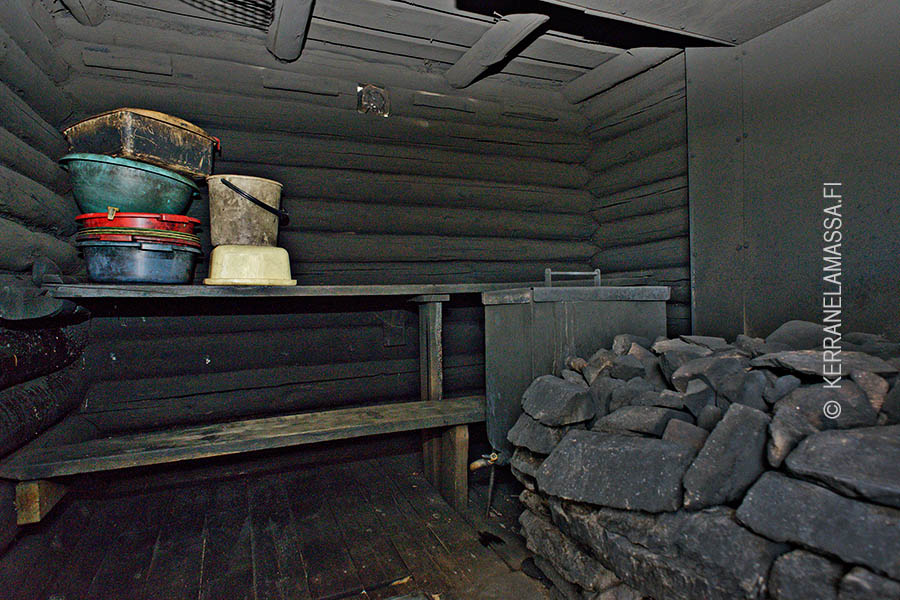
When I’ve washed and changed into fresh clothes it’s already evening. The sun is still high, but the wind has calmed down. It’s time to pack the canoe and continue my journey.
Read more: Sauna in Finland – the Ultimate Guide to Finnish Sauna Culture
Gone fishing
It’s the darkest hour, way past midnight. I stand knee deep in a river, alone, only water and rocks and trees and dark clouds around me. I cast my line behind a stone on the surface. Nothing.
Someone once compared angling to a religion. Casting a lure or a fly is like praying: there’s no guarantee for an answer, but one must believe there’s something on the other side, under the surface, even if eyes can’t see it. An angler must have faith.
Fishing for brown trout takes a lot of patience. It can be easy as a pie or mission impossible depending on the weather, water level and temperature, a dozen other factors – and of course luck. A few years ago my wife tried her hand at angling, and caught a decent trout with her third cast. When I begun trout fishing, it took 10 days of serious work to catch a similar fish. But when I finally succeeded, I was hooked, too. Brown trout is such a lovely fish: beautiful, strong, and delicious.
Brown trout is such a lovely fish: beautiful, strong, and delicious.
In 19th and early 20th century many rapids in Eastern Finland were destroyed when channels were cleared for timber rafting. In recent years these places have been restored fish conservation in mind. Large rocks and gravel have been installed in order to create spawning areas, and small and larger trout are planted on regular basis. Local fishing associations do most of the work and management. Recreational anglers like myself contribute to the effort by purchasing fishing licenses.
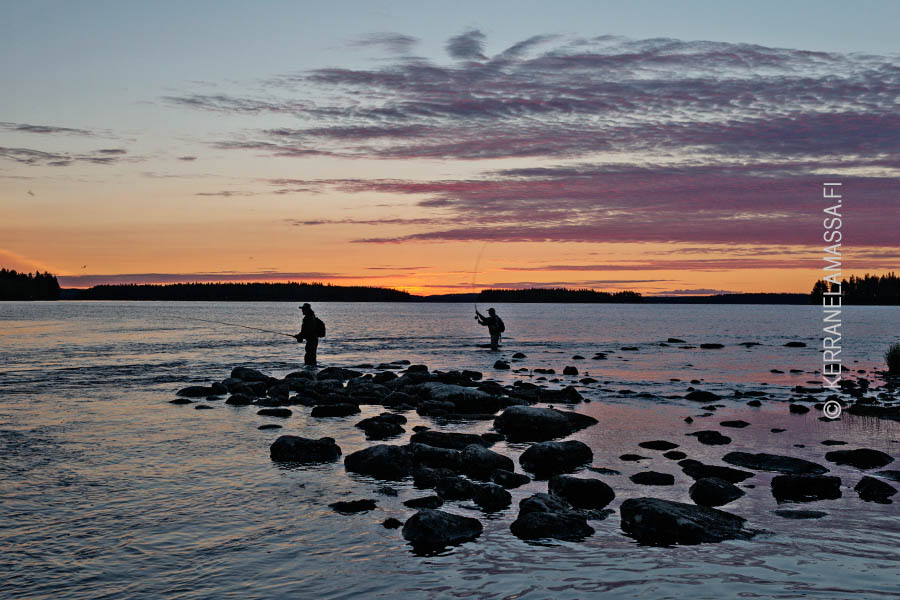
Kuhmo has about a dozen decent rivers and rapids where an angler can cast his line. One of the most famous is Lentua Rapids, a kilometer-long strech of white water and calmer stream between two large lakes, Lentua and Lammasjärvi.
Keeping the faith
Tonight I have the river all for myself. Other anglers have gone to bed, most of them empty-handed. After midnight fishes begin to get more active. Small graylings snatch insects from the surface, and every now and then there’s a louder splash – a trout.
I catch and release a couple of small ones – there’s a 60-centimeter minimum limit for brown trout – and then, finally, get a heavier take. I know immediately that the fish is not a baby.
After the fish has exhausted itself by pulling against my flexible rod I encounter an unexpected problem: clouds make it too dark to use my hand net. I simply can’t see the fish, so I guide it carefully towards the shallows. Just a meter away it struggles one last time and manages to shake off the hook.
Half an hour later the same happens again. I sit on a stone, head in my hands, feeling cursed. Then I shape up, change new hooks to my tiny trout-pattern wobbler – it’s too dark to sharpen the old ones – and wade back to the water.
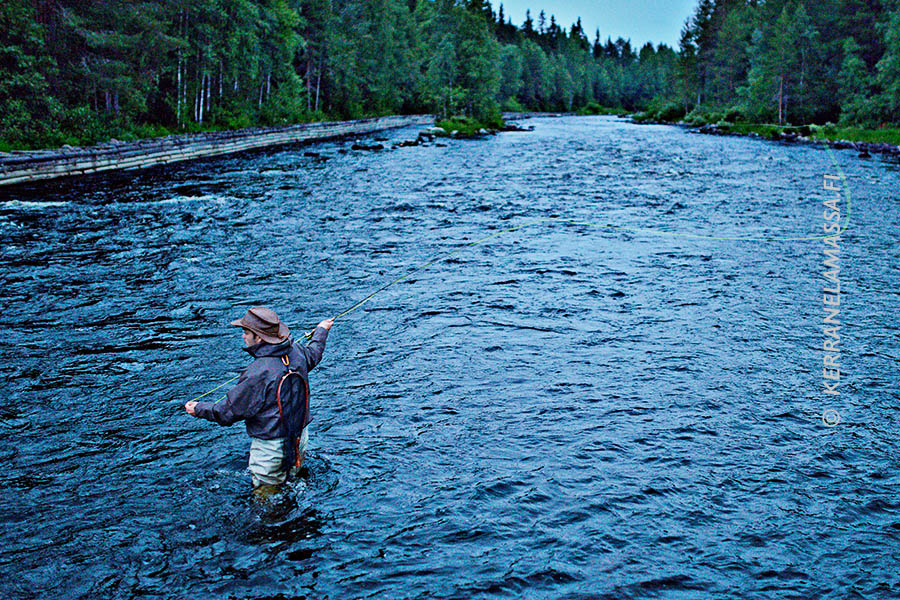
Just when I begin to lose my faith a trout strikes. This fish is unmistakably stronger than the ones that got away. Reel screams as she pulls the line out, and I let her take as much as she wants. The river is narrow, and the trout can’t run far. I keep my rod curved and line tight and take a deep breath.
The fish goes into the middle of river and hides underneath a rock. I wait patiently for several minutes until I realize what’s going on: she’s trying to cut the line against a rock. Very carefully I pull and waggle until the fish gets annoyed. She comes out and rushes downstream with full speed.
I run after the fish, holding my rod up and stumbling on slippery stones, a big smile on my face. I feel alive.
Read more: Fishing in Finland
PRACTICAL INFORMATION
Transportation
Kuhmo (population 10 000) is located in Eastern Finland, close to Russian border. The nearest airport is 100 km away in Kajaani. From Kajaani one can continue to Kuhmo by bus (1h 40min, 20€) or rent a car at the airport. From Oulu airport the distance to Kuhmo is 260 km.
Accommodation
The most sympathetic place to stay is a family-run Lentuankoski Camping. The tiny campsite, located 15 km from Kuhmo center, has a few cabins (2p/40€) and grounds for caravans and tents (2p/16€). Services include shared kitchen, washing machine, showers and sauna. The campsite is only a few hundred meters from Lentua Rapid’s angling hotspots.
A local tourism industry association, Wild Taiga, offers information about accommodation and outdoor activities in Kuhmo.
Bear watching
A few operators organize bear and wolf watching in Kuhmo region. One of the most experienced is Wildlife Safaris Finland, who’s headquarters are located near Russian border. A night in a hide costs 150€, accommodation at the cabin 50€. Wildlife Safaris Finland also has a pick-up service from Kajaani airport and rents professional photography equipment (Nikon).
Petola Visitor Centre, run by Metsähallitus (Finnish forest service), is located a couple of kilometers from Kuhmo center. Petola has a multi-lingual exhibition about bear, wolf, wolverine and lynx, and displays interesting facts about Finland’s predator management politics. The centre also sells fishing licenses and has information about trekking routes. Free entrance.
Angling
Kuhmo has a dozen rapids where trout is planted regularly. The most popular angling spots are Pajakkakoski in Kuhmo center, whitewater Lentuankoski, and Kaarneenkoski in Niva village. Fishing licenses for rapids cost about 11€ per day.
Canoe trips
Erämatkailu Piirainen rents canoes and kayaks (35-45€/day), and can transport them to a starting point of a trip. Extremely helpful owner, Urpo Piirainen, also organizes guided canoe trips and rapid swimming adventures.
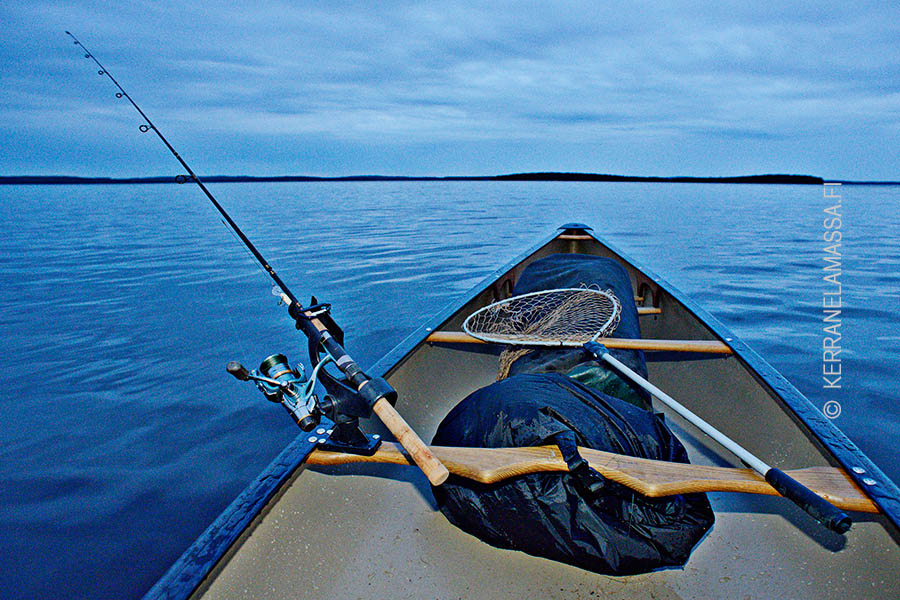
Read more about travelling in Finland: Featuring Finland – Finland Travel Guide





